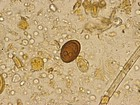Difference between revisions of "Dicrocoelium dendriticum"
Jump to navigation
Jump to search
| Line 43: | Line 43: | ||
'''Definitive hosts''': ''D. dendriticum'' is most commonly seen in sheep, cattle, deer, and goats, but is occasionally seen in horses and pigs. | '''Definitive hosts''': ''D. dendriticum'' is most commonly seen in sheep, cattle, deer, and goats, but is occasionally seen in horses and pigs. | ||
| + | |||
| + | ==Identification== | ||
| + | The adults measure anything between 6mm and 1.0cm long, and are semi transparent. | ||
| + | The eggs are small dark-brown and are shed in the faeces by the infected host. | ||
| + | |||
| + | ==Life Cycle== | ||
| + | |||
*This is a small fluke (<1.5cm) found in the bile ducts of ruminants and some other herbivores | *This is a small fluke (<1.5cm) found in the bile ducts of ruminants and some other herbivores | ||
| Line 48: | Line 55: | ||
**They are therefore much less pathogenic than ''Fasciola'' (which burrow through the liver parenchyma) | **They are therefore much less pathogenic than ''Fasciola'' (which burrow through the liver parenchyma) | ||
*''Dicrocoelium'' is rare in Britain, occurring mainly in the Hebrides, but is common in Europe | *''Dicrocoelium'' is rare in Britain, occurring mainly in the Hebrides, but is common in Europe | ||
| − | |||
**These contain a miracidium | **These contain a miracidium | ||
**If ingested by a land snail, the flukes develop, forming cercariae | **If ingested by a land snail, the flukes develop, forming cercariae | ||
Revision as of 10:16, 16 July 2010
Dicrocoelium dendriticum
| Also known as: | Dicrocoelium lanceolatum
|
Scientific Classification
| Kingdom | Animalia |
| Phylum | Platyhelminthes |
| Class | Trematoda |
| Order | Diagiorchiida |
| Family | Dicrocoeliidae |
| Genus | Dicrocoelium |
| Species | D. dendriticum |
Hosts
Intermediate hosts: Land snails, mainly Zebrina detrita within Europe. Brown ants of the genus Formica are also required for completion of the life cycle.
Definitive hosts: D. dendriticum is most commonly seen in sheep, cattle, deer, and goats, but is occasionally seen in horses and pigs.
Identification
The adults measure anything between 6mm and 1.0cm long, and are semi transparent. The eggs are small dark-brown and are shed in the faeces by the infected host.
Life Cycle
- This is a small fluke (<1.5cm) found in the bile ducts of ruminants and some other herbivores
- The flukes migrate directly up the common bile duct to reach the bile ducts within the liver
- They are therefore much less pathogenic than Fasciola (which burrow through the liver parenchyma)
- Dicrocoelium is rare in Britain, occurring mainly in the Hebrides, but is common in Europe
- These contain a miracidium
- If ingested by a land snail, the flukes develop, forming cercariae
- These are excreted by the snails in slime-balls, which are collected and eaten by wood-ants
- Metacercariae form inside the ants
- The final host is infected when ants are eaten at grazing
- The presence of metacercariae in the nerve ganglia of the ants makes them revert to a primitive behaviour pattern, whereby they cling onto herbage overnight instead of retreating to the nest enhancing the likelihood of being eaten by grazing animals

